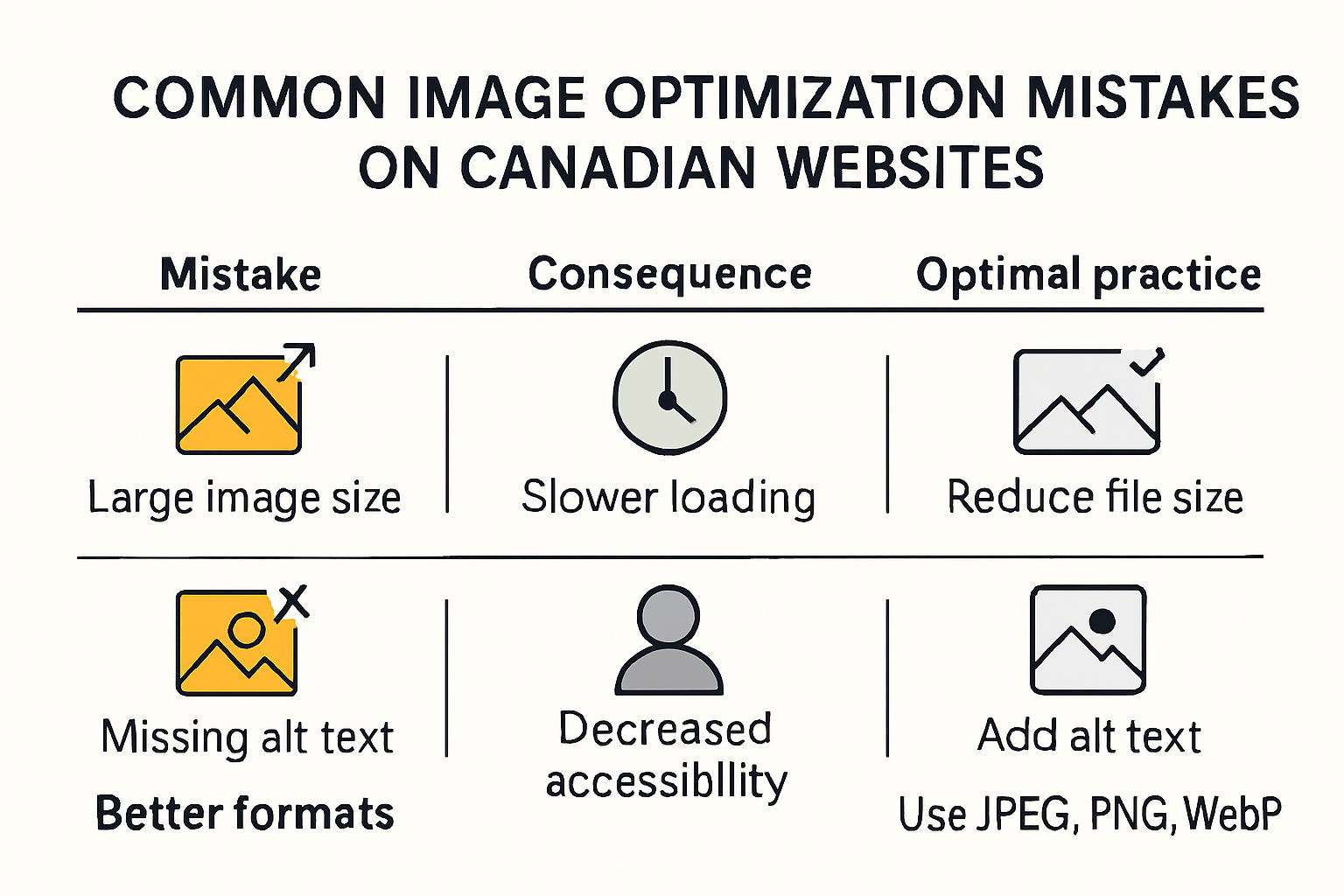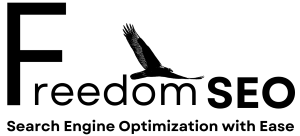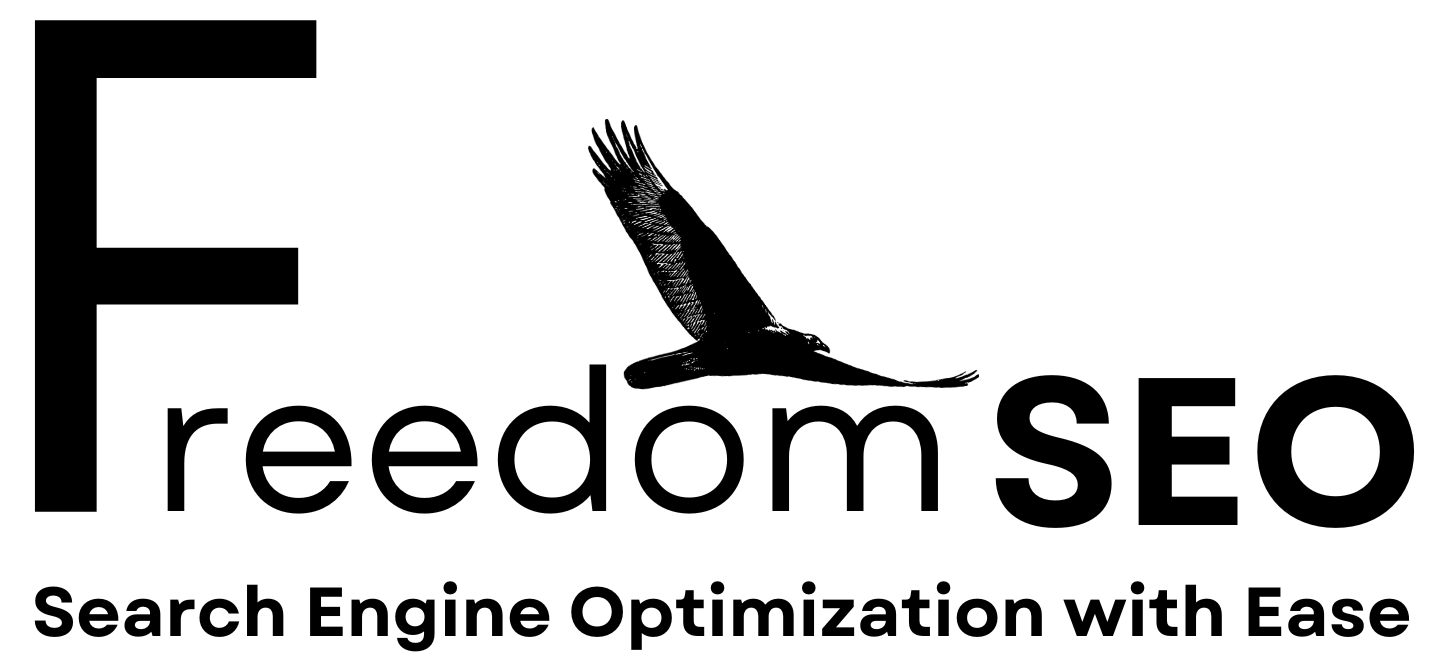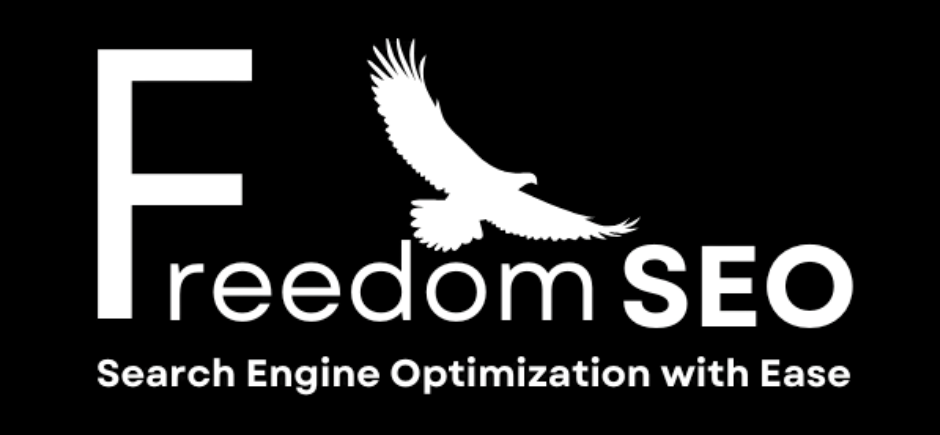Essential Image Optimization SEO Tips for Canadians

Images do a lot more than make your website look appealing. They can secretly make or break your search rankings in Canada. Websites optimized with the right image techniques load up to 40 percent faster than those that skip it. You might think most Canadian businesses have this figured out already. In reality, the most common SEO mistakes are hiding in their images.
Table of Contents
Quick Summary
| Takeaway | Explanation |
|---|---|
| Optimize images for better SEO | Properly optimized images enhance search rankings and page loading times, driving more organic traffic to your site. |
| Use appropriate image formats | JPEG for photos, PNG for graphics, and WebP for overall better quality and reduced size are recommended for efficient loading. |
| Include descriptive alt text | Alt text provides context to search engines and aids accessibility; use relevant keywords and concise descriptions. |
| Implement lazy loading techniques | Lazy loading improves initial page load times by only loading images as they enter the viewport, enhancing user experience. |
| Regularly audit image performance | Continuously reviewing image optimization efforts ensures adaptation to new web standards and maintains SEO effectiveness. |
Why Image Optimization SEO Matters
Image optimization is more than just making pictures look good online. It’s a critical strategy that directly impacts your website’s search engine performance, user experience, and overall digital visibility. For Canadian businesses looking to stand out in a competitive digital landscape, understanding the importance of image optimization SEO is crucial.
Visual Content Performance and Search Rankings
Search engines like Google have sophisticated algorithms that evaluate visual content as a key ranking factor. According to Columbia University’s digital optimization guide , properly optimized images can significantly enhance webpage loading times and improve user experience. Websites with faster loading speeds and high-quality visual content are more likely to rank higher in search results.
The technical aspects of image optimization go beyond aesthetic appeal. File size, resolution, format, and metadata all play critical roles in how search engines interpret and index your visual content. By implementing strategic image optimization techniques, Canadian businesses can improve their website’s overall SEO performance and attract more organic traffic.
User Experience and Engagement Metrics
Images are powerful communication tools that can dramatically increase user engagement. Research analyzing web page metrics demonstrates that well-optimized visual content can significantly impact user behavior, reducing bounce rates and increasing time spent on a website. When images load quickly, are relevant to the content, and provide clear value, users are more likely to stay and explore your website.
For Canadian businesses, this means creating visual content that is not just visually appealing but also strategically designed to enhance user interaction. This involves selecting the right image formats, compressing files without losing quality, and ensuring that images are responsive across different devices and screen sizes.
Accessibility and Comprehensive SEO Strategy
Image optimization is also a critical component of creating an accessible and inclusive website. By adding descriptive alt text, using appropriate file names, and ensuring images are readable by screen readers, businesses can improve their website’s accessibility while simultaneously boosting SEO performance.
Additionally, research comparing web page optimization strategies suggests that while technical SEO techniques are important, they must be balanced with high-quality, credible content. This means your images should not only be technically optimized but also provide genuine value and context to your audience.
For Canadian businesses ready to elevate their online presence, image optimization is no longer optional—it’s a fundamental aspect of a comprehensive digital marketing strategy. By understanding and implementing these techniques, you can improve search rankings, enhance user experience, and create a more engaging online presence.
Step-by-Step Guide to Image SEO
Optimizing images for search engines requires a strategic and systematic approach. Canadian businesses can significantly improve their website’s performance and visibility by following a comprehensive image SEO strategy that goes beyond basic image uploading.
Choosing the Right Image Format and Compression
Selecting the appropriate image format is crucial for balancing visual quality and website performance. According to Google’s official image optimization guidelines , different file formats serve different purposes. JPEG works best for photographs with complex color variations, while PNG is ideal for graphics with transparent backgrounds. WebP format offers superior compression and quality, making it an excellent choice for modern websites.
To help you quickly compare the image formats and compression methods discussed, here’s a table outlining their best uses and benefits for Canadian websites:
| Image Format | Best For | Key Benefit | Notes |
|---|---|---|---|
| JPEG | Photographs with complex colour variance | Good balance of quality and small file size | Widely supported, not ideal for graphics |
| PNG | Graphics, images with transparent areas | Lossless compression, transparency support | Larger file sizes than JPEG |
| WebP | Most modern website images | Superior compression, small file size | Not supported by all legacy browsers |
Compression is equally important. Reduce file sizes without sacrificing image quality by using tools that maintain visual clarity while minimizing loading times. Aim to keep image files under 200 KB whenever possible. This approach not only improves page speed but also enhances user experience and search engine ranking potential.
Optimizing Image Metadata and Descriptive Elements
Metadata plays a critical role in image SEO. Every image should include descriptive, keyword-rich file names that accurately represent the visual content. Instead of generic names like “IMG_001.jpg”, use specific descriptions such as “canadian-business-team-meeting-2024.jpg”.
Alt text is another crucial element for image optimization. Create concise, descriptive alt text that provides context for search engines and assists users with screen readers. The alt text should include relevant keywords naturally, explaining the image’s content and purpose. For example, “Team of marketing professionals discussing SEO strategy in Toronto office” is more effective than “team photo”.
Technical Implementation and Performance Optimization
Technical implementation of image SEO involves multiple strategic considerations. Implement responsive images that adapt to different device screen sizes, ensuring optimal viewing across desktops, tablets, and mobile devices. Use the “srcset” attribute to provide multiple image sizes, allowing browsers to select the most appropriate version.
Create an image sitemap to help search engines discover and index your visual content more effectively. This XML file provides additional information about images on your website, improving their chances of appearing in search results. Learn more about advanced SEO techniques to further enhance your digital marketing strategy.
Additionally, consider using lazy loading techniques that defer image loading until they are about to enter the viewer’s screen. This approach reduces initial page load times and improves overall website performance. Content delivery networks (CDNs) can also help serve images more quickly by distributing them across multiple servers globally.
By meticulously implementing these image SEO strategies, Canadian businesses can create a more engaging, accessible, and search-engine-friendly online presence. Remember that image optimization is an ongoing process requiring regular review and adaptation to emerging web standards and search engine algorithms.
Common Mistakes Canadian Sites Make
Image optimization is a nuanced process that many Canadian businesses overlook, resulting in significant SEO and performance challenges. Understanding these common pitfalls can help websites avoid costly errors and improve their digital presence.
Here’s a summary table showing common image SEO mistakes made by Canadian websites and their consequences:
| Mistake | Description | Potential Impact |
|---|---|---|
| Using large, uncompressed images | Uploading high-res files directly from camera/stock photo | Slow load times, higher bounce rates, lower SEO rankings |
| Generic or missing image file names | Using default names like “IMG_2024.jpg” | Missed SEO opportunities, less search engine context |
| Blank or non-descriptive alt text | Leaving alt text empty or using non-informative placeholders | Reduced accessibility & SEO performance |
| Ignoring responsive and lazy loading | Not adapting images for devices or deferring load | Poor mobile experience, slower perceived page speed |
| Not using image sitemaps or structured data | Failing to help search engines index images effectively | Lower image search visibility |
Neglecting Image Size and Performance
One of the most prevalent mistakes Canadian websites make is uploading large, uncompressed images without considering their impact on page loading speed. Website performance research indicates that images consuming excessive bandwidth can dramatically increase page load times, leading to higher bounce rates and lower search engine rankings.
Many businesses mistakenly upload high-resolution images directly from cameras or stock photo platforms without optimization. These images often exceed 5-10 MB, causing significant performance issues. Professional websites should aim to compress images to under 200 KB while maintaining acceptable visual quality. Using modern image formats like WebP and implementing responsive image techniques can help mitigate these performance challenges.
Overlooking Metadata and Descriptive Elements
Canadian websites frequently underestimate the importance of comprehensive image metadata. Generic file names like “IMG_2024.jpg” provide zero context for search engines, missing crucial opportunities for SEO optimization. Each image should have a descriptive, keyword-rich filename that accurately represents its content.
Alt text is another frequently neglected element. Many sites either leave alt text blank or use non-descriptive placeholders. This not only harms SEO performance but also creates accessibility barriers for users with visual impairments. Effective alt text should be concise, descriptive, and naturally incorporate relevant keywords without appearing spammy.

Ignoring Technical SEO Image Considerations
Technical image SEO involves multiple sophisticated strategies that Canadian businesses often overlook. Failing to implement image sitemaps, not using structured data markup, and neglecting responsive design can significantly impair a website’s image search performance.
Additionally, many sites do not properly implement lazy loading techniques or utilize content delivery networks (CDNs) to optimize image delivery. These technical oversights can result in slower page loads and reduced user engagement. Explore advanced optimization strategies to enhance your website’s technical performance.
By recognizing and addressing these common image optimization mistakes, Canadian businesses can dramatically improve their website’s SEO performance, user experience, and overall digital visibility. Regular audits and a commitment to continuous improvement are key to staying competitive in the evolving digital landscape.

Tools and Resources for Easy Optimization
Navigating image optimization can be challenging for Canadian businesses, but numerous tools and resources can simplify the process and enhance SEO performance. Understanding and leveraging these resources can transform image optimization from a complex task to a straightforward strategy.
Compression and Image Optimization Tools
Compression tools are essential for reducing image file sizes without sacrificing quality. Research on image quality assessment highlights the importance of maintaining visual characteristics like contrast and sharpness during optimization. Free and paid tools offer varying levels of functionality:
- TinyPNG : A user-friendly online tool that compresses PNG and JPEG images with minimal quality loss
- GIMP : An open-source image editing software with advanced compression features
- Adobe Photoshop : Professional-grade tool with robust image optimization capabilities
- ImageOptim : Mac-specific tool that efficiently reduces image file sizes
These tools provide Canadian businesses with accessible options for reducing image file sizes, improving website performance, and enhancing SEO potential.
SEO and Analytics Resources
Several comprehensive tools can help businesses track and improve their image SEO performance. Web ranking research demonstrates the significance of metrics like backlinks and page ranking in online visibility. Recommended resources include:
- Google Search Console : Free tool for monitoring website performance and image indexing
- SEMrush : Advanced SEO platform with image optimization insights
- Ahrefs : Comprehensive SEO tool with detailed image search analytics
- Screaming Frog : Website crawling tool that identifies image SEO issues
These platforms offer detailed insights into image performance, helping businesses refine their optimization strategies. Discover more quick SEO wins to complement your image optimization efforts.
Specialized Image SEO Plugins and Extensions
For websites built on content management systems like WordPress, specialized plugins can streamline image optimization. These tools automate many technical aspects of image SEO, making optimization more accessible for businesses without extensive technical expertise:
- Smush : WordPress plugin that automatically compresses and optimizes images
- EWWW Image Optimizer : Another WordPress tool that offers comprehensive image optimization
- WebP Express : Converts images to WebP format for improved performance
- ShortPixel : Multi-platform image optimization tool with WordPress integration
Canadian businesses can leverage these tools to simplify their image optimization process, ensuring their visual content remains high-quality, fast-loading, and search engine friendly.
By utilizing these tools and resources, businesses can transform image optimization from a complex challenge into a manageable, strategic component of their digital marketing approach. Continuous learning and adaptation remain key to staying ahead in the evolving landscape of SEO and digital marketing.
Frequently Asked Questions
What is image optimization for SEO?
Image optimization for SEO involves techniques to reduce image file sizes, enhance quality, and improve loading times, which can positively impact search engine rankings and user experience.
Why does image size matter for SEO?
Larger image files can slow down website loading times, leading to higher bounce rates and negatively affecting your SEO performance. Optimizing image sizes helps improve load speeds and enhances overall user engagement.
What are the best image formats for web use in Canada?
The best image formats for web use are JPEG for photographs, PNG for images that require transparency, and WebP for superior compression and quality. Selecting the right format can help optimize loading times and maintain visual quality.
How can I implement lazy loading for images?
Lazy loading can be implemented by using the ‘loading’ attribute in the image tag in HTML, allowing images to load only when they are about to enter the viewport, which improves the initial load time of the webpage.
Bring Your Images – and Your Rankings – to the Top in Canada
Is your website quick to load but missing out on the search results you deserve? Struggling with slow images or pages that do not convert visitors into customers? You already know from our article that poor image optimization can silently push your business down the Google rankings and frustrate Canadian customers who expect fast and accessible sites. If you want guaranteed results and need your business found in local searches, now is the time to act. Explore how proper image SEO and local optimization can transform your online presence.

Start working with a 100% Canadian SEO agency that understands your pain points and the unique needs of Canadian businesses. Our experts at Freedom SEO specialize in quick turnarounds, full-service SEO, Google Business Profile management, and high-performing website builds. Do not let image issues or slow loading times hold your rankings back. Take the next step to get into the top 3 spots on Google. Contact our local team now for your custom consultation and experience the difference.
Recommended
-
[
Writing SEO Friendly Content: 2025 Tips for Canadian DIY SEO
]( https://freedomseo.ca/writing-seo-friendly-content-2025-tips-for-canadian-diy-seo )
-
[
Website Speed Optimization Tips for Canadian Businesses 2025
]( https://freedomseo.ca/website-speed-optimization-tips-for-canadian-businesses-2025 )
-
[
Top SEO Quick Wins for Canadian DIY Marketers in 2025
]( https://freedomseo.ca/top-seo-quick-wins-for-canadian-diy-marketers-in-2025 )
-
[
Website Hosting and SEO: Essential Tips for Canadians in 2025
]( https://freedomseo.ca/website-hosting-and-seo-essential-tips-for-canadians-in-2025 )
-
How to Optimize Images For The Web | Effortlessly Professional Websites
-
Optimizacion de imagenes para web 2025: Guia esencial para marketers

















